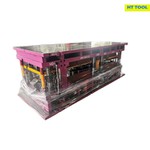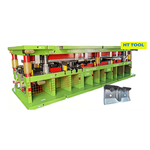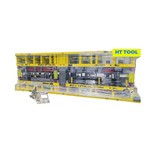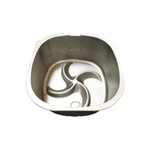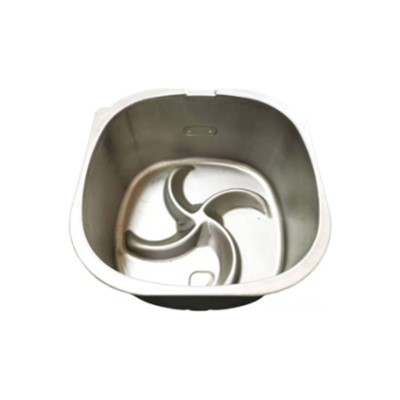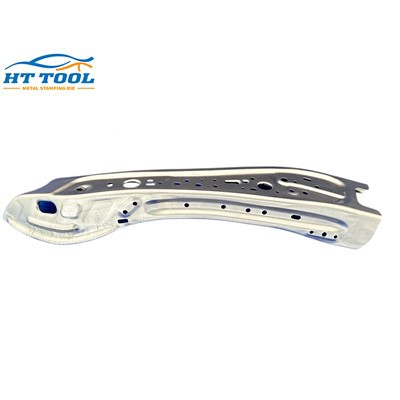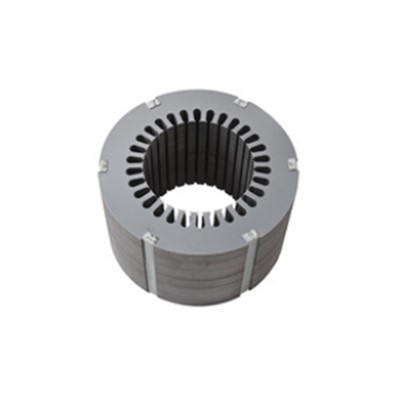Stamping Parts
Company Profile
HT TOOL is highly experienced with Progressive Tooling from medium to high complex parts up to 1300mm width. Our costumers can expect to achieve the maximum productivity/quality from our progressive tools.
Why Choose Us
Rich Experience
Continuously providing our customers with diverse and highest quality die making services and delivering first-class metal stamping dies and parts with precision, accuracy, speed and efficiency.
One-stop Solution
HT TOOL is committed to providing reliable one-stop solutions for the tool and die industry, and through our strengths to become the preferred supplier within the metal stamping die industry.
Professional Team
In tooling design department, we are able to provide a comprehensive service to our customers. Our project managers (x2) are in permanent contact with our customers during the project development process and during the mass production of the dies.
Customized services
Our assembly units offer maximum flexibility to meet our customers' needs, adding value to each part with customer satisfaction in mind.

Stamping is a forming method that uses a press and a die to apply external force to plates, strips, pipes and profiles to cause plastic deformation or separation, thereby obtaining a workpiece (stamping) of the desired shape and size. Stamping and forging are both plastic processing (or pressure processing), collectively known as forging. The blanks for stamping are mainly hot-rolled and cold-rolled steel plates and strips.
Cold stamping parts generally no longer undergo cutting processing, or only require a small amount of cutting processing. The accuracy and surface state of hot stamping parts are lower than those of cold stamping parts, but they are still better than castings and forgings, and the amount of cutting processing is small.
Benefits of Stamping Parts
The stamping process allows for very tight tolerances, meaning that parts can be manufactured to very exact specifications. This is particularly important in industries like aerospace and medical, where precision is essential for safety and functionality.
Since the stamping process is highly automated, the parts produced are consistent in terms of size and shape. This makes it easier for manufacturers to ensure that their products meet quality standards and are free from defects. The stamping process also allows for high repeatability, meaning that the same part can be produced repeatedly without variation in quality.
Stamping presses can be used with materials such as aluminum, steel, copper, and brass. This makes stamping parts a versatile solution for manufacturers who require parts made from different materials. Additionally, stamping parts are cost-effective, especially when compared to other manufacturing processes like casting or forging.
Since dies can be easily changed on a stamping press, custom stamping parts manufacturers can quickly switch between different parts without having to retool their entire production line. This allows for a greater degree of customization, enabling manufacturers to produce unique parts that meet the specific needs of their customers.
Other Types of Stamping Parts
Punching and shearing dies
The work is completed by shearing action. Common forms include shearing dies, blanking dies, punching dies, trimming dies, edge trimming dies, hole pulling dies and punching dies.
01
Bending dies
It is to bend the flat blank into an angle. Depending on the shape, precision and production volume of the parts, there are many different forms of dies, such as ordinary bending dies, cam bending dies, curling dies, arc bending dies, bending and seam dies and twisting dies.
02
Drawing dies
Drawing dies are used to make flat blanks into seamless containers with bottoms.
03
Forming dies
It refers to the use of various local deformation methods to change the shape of the blank. Its forms include convex forming dies, curling forming dies, necking forming dies, hole flange forming dies, and round edge forming dies.
04
Compression die
It uses strong pressure to make the metal blank flow and deform into the desired shape. Its types include extrusion die, embossing die, stamping die, and end pressure die.
05
What Materials Can Be Used for Stamping Parts
Steel
Steel is one of the most commonly used materials for stamping due to its strength, durability, and affordability. Different types of steel, such as carbon steel, stainless steel, and alloy steel, can be used depending on the desired properties of the stamped part.
Aluminum
Aluminum is lightweight, corrosion-resistant, and easily recyclable, making it suitable for a wide range of stamped parts, especially those requiring reduced weight or resistance to corrosion.
Copper
Copper is valued for its excellent electrical conductivity and thermal conductivity, making it suitable for stamped parts used in electrical components, heat sinks, and plumbing applications.
Brass
Brass is an alloy of copper and zinc, offering good corrosion resistance, machinability, and aesthetic appeal. It's commonly used for decorative stamped parts, as well as components requiring high wear resistance.
Bronze
Bronze, an alloy of copper and other metals such as tin or aluminum, is known for its strength, corrosion resistance, and wear resistance. It's often used for bearings, bushings, and other mechanical components.
Nickel and Nickel Alloys
Nickel and nickel alloys offer excellent corrosion resistance, high temperature resistance, and electrical conductivity, making them suitable for stamped parts used in harsh environments or requiring specialized properties.
Titanium
Titanium is valued for its high strength-to-weight ratio, corrosion resistance, and biocompatibility. It's commonly used in aerospace, medical, and marine applications where lightweight, durable stamped parts are required.
Plastics
Certain plastics, such as ABS, polycarbonate, and polypropylene, can also be stamped to create lightweight, cost-effective parts for various applications, including automotive, electronics, and consumer goods.
What are the applications of stamping parts in automobile manufacturing?
Stamping parts play an extremely important role in automobile manufacturing, and almost every car contains a large number of stamping parts. The following are some of the main applications of stamping parts in automobile manufacturing:
Body structure parts
Stamping parts are often used to manufacture the body structure of the car, including doors, roofs, side panels, floors and other parts. These structural parts not only constitute the appearance of the car, but also undertake the important task of protecting the safety of the occupants.
Chassis parts
The chassis is the basic frame of the car, and stamping parts play a key role in the manufacture of the chassis, including crossbeams, longitudinal beams, brackets and other parts, which provide the car with the necessary support and stability.
Interior and exterior trims
Stamping technology is also used to manufacture interior and exterior trims of cars, such as dashboards, door trims, grilles, etc. These parts not only enhance the beauty of the car, but also improve the comfort of riding.
Engine parts
Stamping parts are also used to manufacture various parts of the engine, such as cylinder heads, oil pans, etc., which are crucial to the performance and reliability of the engine.
Safety system components
Stamping parts also play an important role in the safety system of automobiles, such as seat belt buckles, airbag covers, etc. These parts are crucial to the safety protection of passengers.
What is the production process of stamping parts?
The production process of stamping parts refers to the process of processing metal sheets into specific shapes through stamping equipment. The details are as follows:




Prepare raw materials
The production of stamping parts mainly uses metal materials such as steel, aluminum, copper, etc. Before formal production, it is necessary to prepare the required raw materials and perform cutting, cutting and other processing to meet the next step of manufacturing needs.
Design and manufacturing of stamping parts
The design of stamping parts is an important link in the production process, and different design schemes need to be formulated according to different use environments. After the design is completed, it is necessary to make a mold and use machines such as punch presses to perform stamping processing to realize the manufacturing of stamping parts.
Mold selection and production
The selection and production of molds are crucial to the quality and precision of stamping parts. It is necessary to select suitable molds according to different requirements such as the shape, size and batch of stamping parts, and design and produce suitable molds.
Stamping processing
Stamping processing is the main link in the manufacturing of stamping parts, and it is also a key link in determining the quality and precision of stamping parts. The mold needs to be installed on the punch press, and the raw materials are processed into the required stamping shape by mechanical force.
Surface treatment
After the stamping parts are manufactured, surface treatment is required to improve the corrosion resistance and aesthetics of the stamping parts. Surface treatment methods include galvanizing, electroplating, spraying and other methods. It is necessary to select the appropriate surface treatment method according to different use environments.
Cleaning process steps for stamping parts
These are the 4 phrases that are carried out for the cleaning of a stamping process.
Degreasing
At this stage, the stamped parts undergo a washing process to remove any residue, oil or loose particles that may have adhered during the stamping process.
Washing is essential to prepare the parts for the next stages and to ensure a clean surface.
The machine ensures thorough cleaning without affecting the structural integrity of the parts thanks to its design and the use of suitable detergents to remove oils and drilling oils.
Rinse
After washing, the parts go through a rinsing stage to remove any residue of the cleaning agents used.
This step is crucial to ensure that no chemical residues are left behind that could affect the quality of the final finish or the adhesion of subsequent coatings.
Passivation
The passivation phase involves treating the surface of the stamped parts to improve their corrosion resistance.
This process often involves the use of chemical solutions that create a protective layer on the metal, reducing susceptibility to oxidation and improving the durability of parts in corrosive environments.
Drying
After completing the above stages, the parts go through a drying process to remove any remaining liquid residue.
Proper drying is essential to avoid the formation of water spots or residues on the surface of the parts.
Stamping is a forming method in which a punch and die apply external force to raw materials such as plates, strips, and tubes to plastically deform or separate them to obtain the desired shape and size of the workpiece. Stamping parts are widely used and easy to find in life.
Stamping dies are equipment used for pressure treatment of materials. Its working principle is usually under the action of the mold, punching between the upper and lower molds through the opening and closing of the upper and lower molds, punching and stretching the raw materials to form stamping parts.
The mechanical press completes the stamping process through the movement of the sliding block driven by the motor, while the hydraulic press drives the hydraulic cylinder to reciprocate through the hydraulic principle to complete the stamping process.
The mechanical press has fast reciprocating speed, fast speed and high efficiency, but the force generated is very small. It is usually used in small stamping equipment or stamping and shearing processes. The hydraulic press can produce a large force, but the speed is relatively slow. Usually used for stretching and forming production, but also for blanking and cutting of large parts.

Our Factory
With ISO9001 certification and a mature design system. The press capacity is from 200T to 800T. Relying on a perfect quality control system. We strive to provide our customers the best product.We offer a wide range of Other Metal Stamping Dies products.

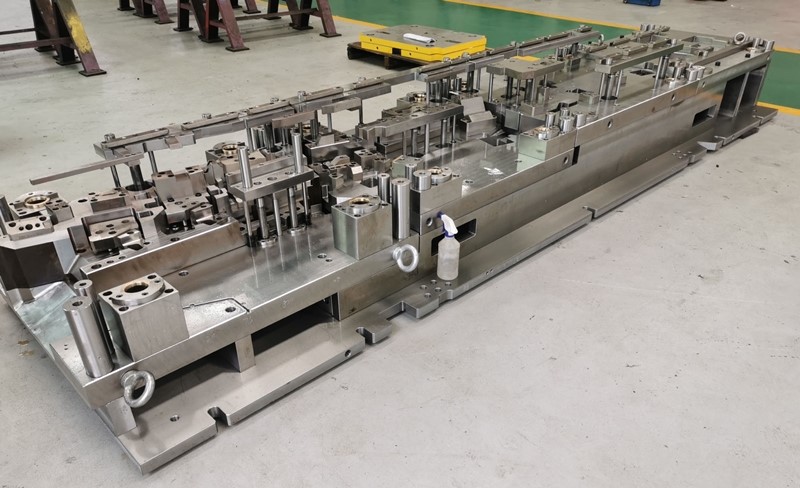

Certificate




